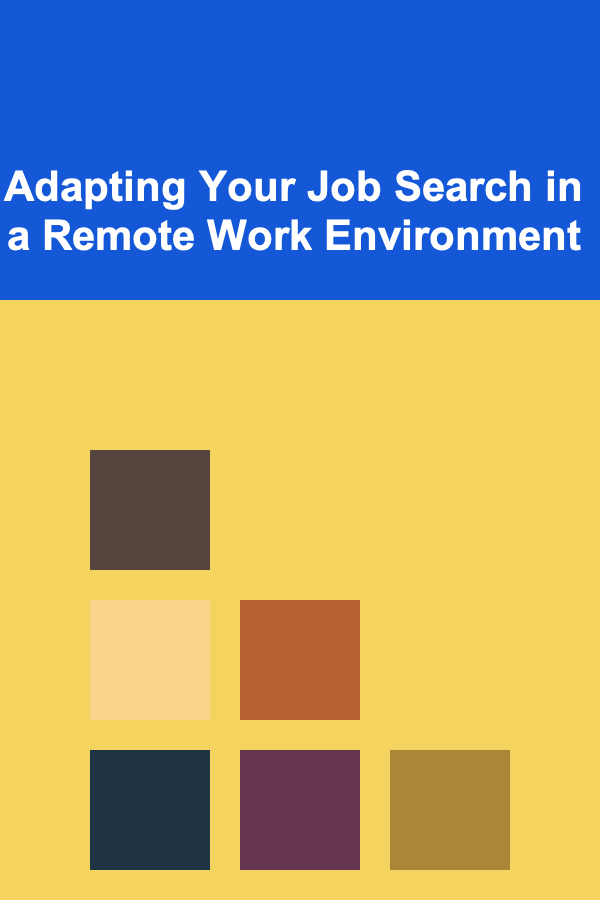
Adapting Your Job Search in a Remote Work Environment
ebook include PDF & Audio bundle (Micro Guide)
$12.99$11.99
Limited Time Offer! Order within the next:

The job market has undergone a seismic shift over the past few years, primarily due to the rise of remote work. What was once seen as a niche offering has now become the norm for many industries and positions. Whether you're a seasoned professional or someone just entering the workforce, adapting your job search to the remote work environment is crucial. This guide will explore actionable strategies to help you effectively navigate the remote job market, focusing on key areas such as job search techniques, application strategies, and interview preparation.
Understanding the Remote Job Market
Remote work isn't just about finding jobs that allow you to work from home; it requires a shift in mindset and strategy. Unlike traditional office jobs, remote positions often come with their own unique set of challenges and expectations. Remote work allows companies to hire talent globally, meaning that your competition isn't just local---it's international.
The demand for remote work has exploded in various sectors, including tech, marketing, design, customer support, and sales. With this growth comes an increase in job listings, but also an increase in competition. To stand out in this crowded field, it's essential to understand the nuances of remote work and tailor your job search accordingly.
Step 1: Define What You Want from Remote Work
Before diving into job applications, it's crucial to understand what you're looking for in a remote job. While remote work offers incredible flexibility, not all remote positions are created equal. Some are hybrid (a combination of in-office and remote work), while others are fully remote. Moreover, remote work can vary greatly in terms of work culture, expectations, and level of autonomy.
Here's what you need to think about before starting your job search:
1.1 Work Schedule Flexibility
- Asynchronous vs. Synchronous Work: Some remote jobs require you to be available at specific times (synchronous), while others allow you to complete tasks independently, without needing to follow a strict schedule (asynchronous). Understanding which work style aligns with your lifestyle is key.
1.2 Company Culture
- Remote-First vs. Hybrid Teams: Some companies have adopted a remote-first philosophy, meaning remote work is their default mode, and employees are not expected to come into the office at all. Others have hybrid models where remote employees must come to the office a few times a month or year.
1.3 Job Type and Industry
- Remote-Friendly Industries: Certain industries are more conducive to remote work. For example, software development, digital marketing, writing, and graphic design are all well-suited for remote roles, while manufacturing or healthcare roles may require physical presence.
Identifying the type of remote work that suits you will help narrow your job search, making it more targeted and efficient.
Step 2: Master the Art of Remote Job Search Platforms
While traditional job boards like LinkedIn or Indeed still offer remote job listings, specialized platforms dedicated to remote work have become essential for job seekers in today's market.
2.1 Use Remote-Specific Job Boards
Platforms like We Work Remotely , Remote.co , FlexJobs , and Remote OK specialize in remote job opportunities. These sites focus specifically on roles that offer remote work, helping you avoid the hassle of sifting through non-remote listings.
2.2 Explore Freelance and Contract Work Platforms
If you're open to contract or freelance work, platforms like Upwork , Fiverr , and Toptal offer remote opportunities. These platforms cater to a variety of professions, from programming to writing and marketing, and are a great way to build remote experience, which can be particularly valuable when transitioning to full-time remote roles.
2.3 Utilize LinkedIn Effectively
LinkedIn is a goldmine for job seekers, but you need to adjust your search settings. Use filters to target remote work specifically, and engage with posts about remote job openings. Follow companies that are known for their remote work culture and consider reaching out to recruiters who specialize in remote roles. Be proactive by joining remote work-focused groups and engaging in discussions.
2.4 Leverage Networking
Networking remains one of the most effective ways to find remote job opportunities. Many remote jobs are never posted publicly and are filled through internal recommendations or referrals. Use LinkedIn to connect with professionals who are already working remotely and engage in communities or online forums that are dedicated to remote work.
Step 3: Tailor Your Resume and Cover Letter for Remote Jobs
In a competitive remote job market, your resume and cover letter must be tailored to highlight the skills and qualities that remote employers value most. Simply listing your qualifications won't be enough---your application materials need to reflect your ability to thrive in a remote work environment.
3.1 Highlight Remote Work Skills
- Self-Discipline and Time Management: Remote workers need to be highly self-motivated and able to manage their time without direct supervision. Highlight examples of when you've successfully managed projects or met deadlines independently.
- Communication Skills: In a remote environment, clear communication is paramount. Be sure to emphasize your ability to collaborate through digital platforms like Slack, Zoom, or Microsoft Teams.
- Tech Savvy: Highlight your proficiency with remote work tools. If you have experience with project management software like Trello, Asana, or Jira, be sure to mention it.
3.2 Show Results from Remote or Flexible Jobs
If you have prior remote work experience, make sure to include specific achievements from those roles. For instance, if you worked remotely as a content writer, you could highlight how your work contributed to a certain percentage increase in website traffic. This shows that you can deliver results in a remote setting.
3.3 Focus on Remote Job-Related Soft Skills
Remote work requires strong interpersonal skills, particularly when working across different time zones or cultures. Your cover letter should emphasize your adaptability, problem-solving skills, and your comfort with working independently while being part of a virtual team.
Step 4: Prepare for Remote Job Interviews
Remote job interviews are different from traditional ones. You'll likely be interviewed via video, and the interviewer will want to assess your ability to communicate and present yourself in a virtual environment.
4.1 Master Video Interview Etiquette
- Test Your Equipment: Always ensure that your camera, microphone, and internet connection are working properly. A poor technical setup can make a bad first impression.
- Choose the Right Setting: Conduct the interview in a quiet, well-lit space. Make sure the background is tidy and professional. Avoid distractions.
- Be Professional Yet Comfortable: While you're working from home, treat the interview with the same level of professionalism you would in person. Dress appropriately and be mindful of body language.
4.2 Showcase Your Remote Skills During the Interview
- Communication Skills: During the interview, focus on how you express yourself clearly and confidently. Remote workers must communicate well via written and spoken methods, so this is your opportunity to demonstrate those skills.
- Adaptability: Share examples of how you've handled challenges in a remote setting. Whether it's working with teams across time zones or handling technical issues, flexibility is key for remote employees.
4.3 Prepare for Technical Questions Related to Remote Work
Be ready for questions about your experience with remote tools, managing your time, and staying productive without in-person supervision. Employers want to know how you will handle remote work dynamics such as asynchronous communication, isolation, and managing distractions.
Step 5: Stay Persistent and Flexible
The remote job market can be competitive, so staying persistent is critical. Here are a few tips to keep you on track:
5.1 Be Open to Temporary or Contract Roles
Temporary or freelance roles are an excellent way to gain remote experience. Even if you're seeking full-time remote work, consider accepting a contract role to build your portfolio and network. These opportunities can often lead to full-time offers, especially if you prove yourself to be a reliable remote worker.
5.2 Keep Improving Your Remote Work Skills
As remote work continues to evolve, employers will look for candidates who are not only skilled in their profession but also well-versed in remote work dynamics. Stay up-to-date with tools, software, and trends in the remote work landscape. Take online courses or workshops related to remote collaboration tools, time management, or digital communication.
5.3 Don't Get Discouraged by Rejection
Rejection is a part of any job search, but it can be especially discouraging when the competition is fierce. However, each interview is an opportunity to learn and improve. Stay positive, keep refining your resume, and continue building your online presence.
Conclusion
Adapting your job search to the remote work environment involves more than simply searching for remote positions. It requires understanding the nature of remote work, tailoring your applications, preparing for virtual interviews, and staying flexible throughout the process. With the right mindset, preparation, and persistence, you can successfully navigate the remote job market and secure a position that fits both your professional goals and lifestyle.
In a world where remote work is increasingly becoming the standard, embracing these strategies will give you the edge you need to stand out in a competitive and evolving job market.
Reading More From Our Other Websites
- [Personal Care Tips 101] How to Start a Digital Detox for Improved Mental Clarity and Productivity
- [Personal Financial Planning 101] How to Manage Finances After a Divorce
- [Screen Printing Tip 101] Mastering Color Layers: Advanced Techniques for Stunning Screen Prints
- [Home Space Saving 101] How to Maximize Small Bedrooms with Clever Storage Solutions
- [Organization Tip 101] How to Downsize Your Belongings Before a Move
- [Home Holiday Decoration 101] How to Choose the Perfect Holiday Light Strings for Your Home
- [Skydiving Tip 101] How to Choose the Perfect Drop Zone for Your Group's Skydiving Trip
- [Stamp Making Tip 101] Mastering Leather Stamping: A Step-by-Step Guide for Beginners
- [Home Space Saving 101] How to Set Up a Functional Corner Desk for a Small Office
- [Personal Care Tips 101] How to Remove Full-Face Makeup Gently Without Scrubbing

How to Maintain Your Home's Foundation and Prevent Structural Issues
Read More
How to Make Money Online as a Lawyer: 10 Actionable Ideas
Read More
How to Organize Your Cleaning Supplies Effectively
Read More
How to Protect Your Home from Water Damage in the Winter
Read More
How to Use Storage Bins for School Supplies
Read More
How To Master Competitive Snowboarding (Slopestyle, Halfpipe)
Read MoreOther Products

How to Maintain Your Home's Foundation and Prevent Structural Issues
Read More
How to Make Money Online as a Lawyer: 10 Actionable Ideas
Read More
How to Organize Your Cleaning Supplies Effectively
Read More
How to Protect Your Home from Water Damage in the Winter
Read More
How to Use Storage Bins for School Supplies
Read More